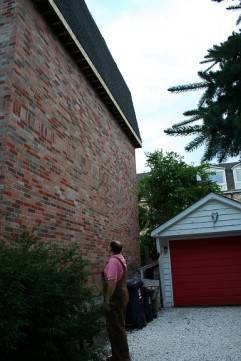Oysterman Rodney Clark and developer Hans Jain find an environmentally friendly way to settle what could have been a nasty legal battle
Dave LeBlanc - Globe and Mail

We've all heard of a "golden handshake." Now, thanks to environmental lawyer David Donnelly, Toronto has just witnessed its first green handshake, which may set a precedent for homeowners in older neighbourhoods facing the pressures of infill development.
Shaking hands are self-described "urban oysterman" Rodney Clark, a 17-year resident of east-end Kimberley Ave. and owner of Rodney's Oyster House on King St. West, and developer Hans Jain of Atria Development Corporation.
At issue is Mr. Jain's eight-unit townhouse development, near Main and Gerrard
Streets. While seven of the units quietly snake behind the backyard fence of Mr. Clark's handsome century home, the sole detached unit comes within inches of Mr. Clark's quahog shell-covered driveway, and its tall, blank wall substitutes a good deal of his blue-sky view with unwanted shadows.
"He was shouting into the phone that he had just woken up to the sight of the Trump Tower screening out his sunlight," remembers Mr. Donnelly about the phone call he received from Mr. Clark, who had just come home from a lengthy business trip. "He likes to tell a good story so I thought he was either pulling my leg or he'd switched up his medication."
Since Mr. Clark was an old friend - the two know each other through mutual participation in the Ontario Oyster Festival and its support of the advocacy group Environmental Defence - Mr. Donnelly drove over and had a look. While Mr. Donnelly was aware that Atria had purchased the lot with development approvals already in place and, further, that Mr. Clark and his neighbours had fought the previous developer to reduce the scale and impact of the infill project, he was still "quite surprised" at the size of the one detached house: "It really does dominate that part of the street and certainly overshadows a good part of Rodney's property."
So, after calming Mr. Clark down, he arranged a meeting with Mr. Jain. His expectations for a resolution were high, since he'd had past dealings with the Jain family and found them to be "first-class developers." However, since Ontario does not have "right to light" legislation, which exists in some American states and the United Kingdom, he knew his friend would be "out of luck in terms of the traditional planning tools to force some kind of compliance on Mr. Jain."
In other words, the three men would have to find a more creative solution.
Mr. Clark did have a small bargaining chip. In order to finish masonry and roofing work, Mr. Jain would need to rent Mr. Clark's driveway to erect scaffolding. But, instead of a simple cash payout, Mr. Donnelly suggested that Atria install a solar-thermal unit on Mr. Clark's roof so he could "capture what's left of his sunlight and turn it into green energy," says the lawyer. That way, "every time Rodney takes a shower or does his dishes he can think, 'You know, there's something positive that has come out of this experience about being impacted by infill development.' "
"It's not as bad as lobster fishermen getting a poor catch and getting a subsidy from the Minister of Fisheries," adds Mr. Clark, "and it's not that everyone should be at the front door receiving a cheque - it's that [Atria is] changing the design of the community, therefore they have to put something back into it."
Mr. Jain agrees: "We have to work with our neighbours, and [Mr. Clark] seemed like a reasonable guy; we could have had a long and protracted discourse with lawyers and all of that on a really adversarial basis but, I think, on both our sides it doesn't pay."
In addition to the solar panel, Mr. Jain agreed to hire a local landscape architect to soften the tall, blank wall with plantings. And he's decided to incorporate more sustainable features into future projects: "You want to do better for your children," he says, simply.
After the green handshake, Mr. Donnelly drew up a formal contract, which he hopes will serve as a model for future homeowners in similar situations. Until, that is, the province passes its own right-to-light legislation: "It's the next big battleground on the road to Ontario's sustainable energy future."
It is legislation Mr. Donnelly would be happy to help prepare in order to protect both the homeowner and their sunlight but also allow people to develop more intensively in urban areas. "We have [older and underutilized] two-storey buildings along a subway line, so we have a long way to go," he says. "The [city's official] target is a half-million people in downtown Toronto, in my opinion it should be a million or more and there's only one way to go and that's up."
And, just like an oyster covering an unwanted irritant to form a pearl, so too has Mr. Clark turned what could have been an irritating real estate situation into something much more palatable: "There has to be in the community stewardship, sustainability and some realization that we all have to fish off the same wharf."
***
Globe and Mail: http://www.theglobeandmail.com/real-estate/a-green-solution-to-a-neighbours-spat/article1213370/

